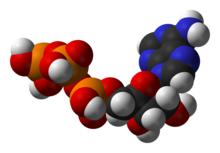
Back Metabolisme Afrikaans Stoffwechsel ALS ገንባፍራሽ ቅንባሮ Amharic Metabolismo AN أيض Arabic বিপাক ক্ৰিয়া Assamese Metabolismu AST Метаболизм AV Maddələr mübadiləsi Azerbaijani متابولیسم AZB

Metabolism is the chemical reactions which keep us alive. It happens in the cells of living organisms.
The chemical reactions are catalyzed by enzymes. Metabolism allows organisms to grow, reproduce, maintain their structures, and respond to their environments. The word ‘metabolism’ can also refer to digestion and the transport of substances into and between different cells.
Metabolism is usually divided into two categories:
- Catabolism breaks down organic matter and harvests energy by way of cellular respiration.
- Anabolism uses energy to build molecules such as proteins and nucleic acids.
The chemical reactions of metabolism are organized into metabolic pathways, or cycles, like the Krebs cycle. One chemical is transformed through a series of steps into another chemical by a series of enzymes.
The metabolic system of an organism decides which substances it finds nutritious and which poisonous. For example, some prokaryotes use hydrogen sulfide as a nutrient, yet this gas is poisonous to animals.[1] The speed of metabolism, called the metabolic rate, influences how much food an organism will need, and how it is able to get that food.
A striking feature of metabolism is the similarity of the basic metabolic pathways and components between even vastly different species.[2] For example, the set of carboxylic acids that are best known as the intermediates in the citric acid cycle are present in all known organisms, being found in species as diverse as the unicellular bacterium Escherichia coli and huge multicellular organisms like elephants.[3] These striking similarities in metabolic pathways are likely due to their early appearance in the evolution of life, and kept because of their efficiency.[4][5]
- ↑ Friedrich C. (1998). "Physiology and genetics of sulfur-oxidizing bacteria". Adv Microb Physiol. Advances in Microbial Physiology. 39: 235–89. doi:10.1016/S0065-2911(08)60018-1. ISBN 9780120277391. PMID 9328649.
- ↑ Pace N.R. (2001). "The universal nature of biochemistry". Proc. Natl. Acad. Sci. U.S.A. 98 (3): 805–8. Bibcode:2001PNAS...98..805P. doi:10.1073/pnas.98.3.805. PMC 33372. PMID 11158550.
- ↑ Smith E. & Morowitz H. (2004). "Universality in intermediary metabolism". Proc Natl Acad Sci USA. 101 (36): 13168–73. Bibcode:2004PNAS..10113168S. doi:10.1073/pnas.0404922101. PMC 516543. PMID 15340153.
- ↑ Ebenhöh O. & Heinrich R. (2001). "Evolutionary optimization of metabolic pathways. Theoretical reconstruction of the stoichiometry of ATP and NADH producing systems". Bull Math Biol. 63 (1): 21–55. doi:10.1006/bulm.2000.0197. PMID 11146883. S2CID 44260374.
- ↑ Meléndez-Hevia E; Waddell T. & Cascante M. (1996). "The puzzle of the Krebs citric acid cycle: assembling the pieces of chemically feasible reactions, and opportunism in the design of metabolic pathways during evolution". J Mol Evol. 43 (3): 293–303. Bibcode:1996JMolE..43..293M. doi:10.1007/BF02338838. PMID 8703096. S2CID 19107073.
{{cite journal}}: CS1 maint: multiple names: authors list (link)